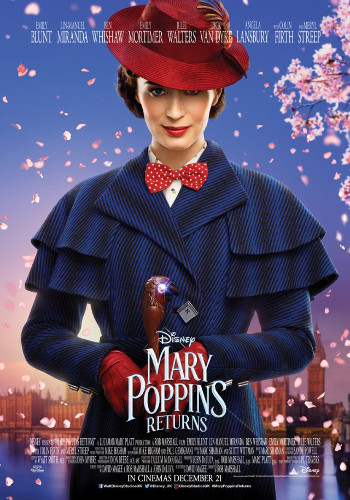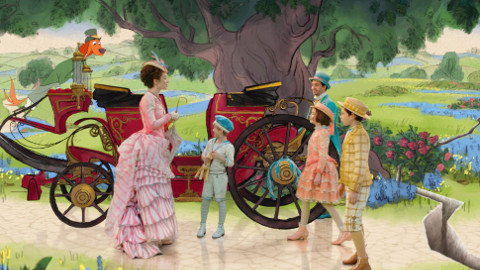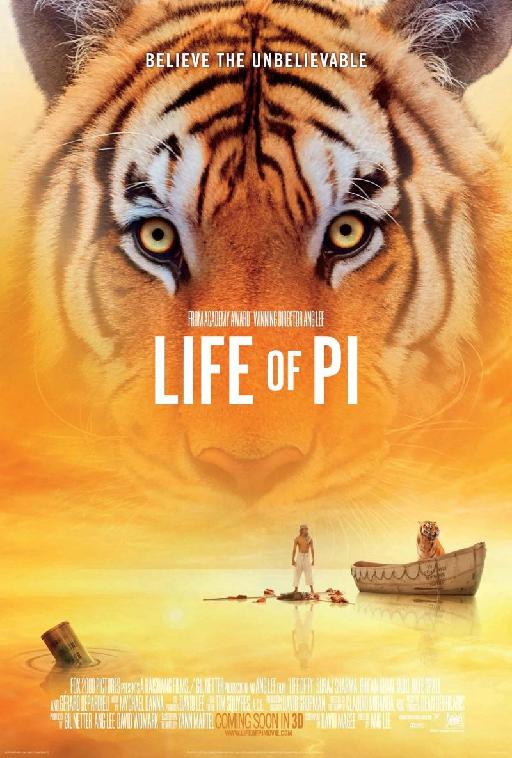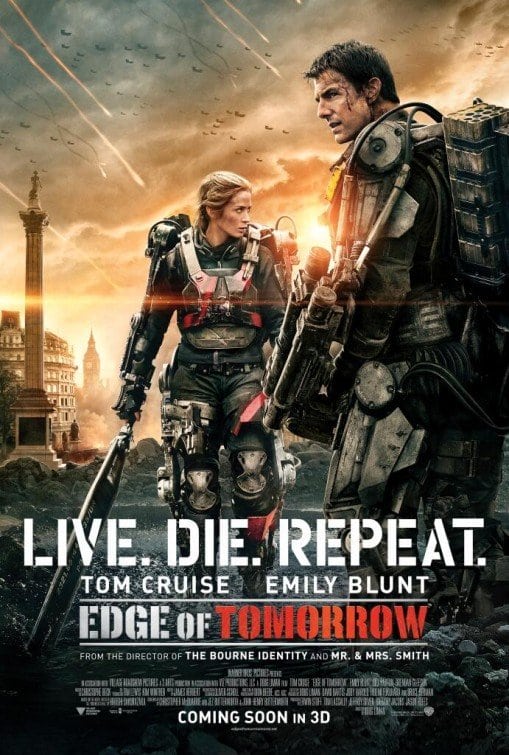Mary Poppins Returns (2018)
Directed by: Rob Marshall
Written by: David Magee, John DeLuca, P.L. Travers, Rob Marshall
Starring: Ben Whishaw, Emily Blunt, Emily Mortimer, Lin-Manuel Miranda
USA
IN CINEMAS NOW
RUNNING TIME: 130 mins
REVIEWED BY: Dr Lenera, Official HCF Critic
It’s the time of the “Great Slump’ [the term for the Great Depression in the United Kingdom]. Recently widowed Michael Banks is struggling to raise his three children alone, even though his labour organiser sister Jane does what she can to help. He’s ran up a debt and the Fidelity Fiduciary Bank sends round two lawyers to inform him that his family home is in foreclosure, and that he’s only got until Friday at midnight to pay up. His late father gave him shares at the bank, but Michael has lost the certificate that proves his ownership. When a gust of wind blows away a childhood kite he’d intended to sell, Mary Poppins descends from the clouds with it. Michael and Jane are astonished to see that their old nanny hasn’t changed a bit, and Michael reluctantly agrees to let her stay at their home to look after his children, who she begins to take on amazing adventures….
It really shouldn’t work. Mary Poppins Returns [which probably has the record for the longest period of time between an original film and a first follow-up] is technically a sequel to the 1964 family favourite [which I do love, though ‘shock horror’ I’ve always loved Bedknobs And Broomsticks even more] with Mary involving herself with the same family many years later. But within seconds of hearing the film’s opening words coming out of the mouth of Lin-Manuel Miranda’s [playing Jack, a former apprentice of Bert] in a cockney accent as deliberately rubbish as Dick van Dyke’s in the original movie, it’s apparent that it’s almost as much a remake, with so many of its ingredients deliberately mirroring things from 1964, and a few of them being almost the same, along with a never ending stream of references. Admiral Boom is still up on top of that house firing his ship’s cannon to mark the time. We have another father who’s lost his inner child and needs to spend more time with his offspring before it’s too late. Mary and Jack takes the children on a journey into a magical land rendered by hand drawn animation and even those penguins show up. Mary and Jack take the children into the house of an eccentric relative who has issues with gravity. Lamplighters do a big dance instead of chimney sweepers. The mother of the children is involved with a political movement. Mary looks in the mirror and her reflection doesn’t move while she does. The instrumental parts of the music score even include quotes from some of the original songs. Etc, etc, etc. It’s both a massive nostalgia trip and a deliberate attempt to replicate the charms of the original – indeed replicate the original full stop – for a modern audience.
And yet, the result somehow manages to be quite magical, a film which proves that – yes – they can still make ‘em like they used to. It’s really quite astonishing that Mary Poppins Returns has turned out the way it has. I’m sure that the temptation must have been huge to add a bit of modern snarkiness or cyncism, to wink to the audience to say that “yes, we know all this is terribly old-fashioned”. The set pieces may be bigger, the special effects may be smoother [though it’s so wonderful to see some traditional animation on the screen again], the pace may be faster, there may be some very obvious ethnic placing in what’s supposed to be 1935 London, there may even be some action scenes – but it’s still a 1964 film at heart, and all the better for it. Even the songs are surprisingly good and seem like they’re from another age. No, composer Marc Shaiman and lyricist Scott Wittman’s efforts don’t match the achievements of the Sherman Brothers, none of what they came up with will stick in the public’s consciousness like A Spoonful Of Sugar, Supercalifrahalisticexpedous and Let’s Go Fly kite, but then again did anyone seriously expect them too? In their own way most of them are very impressive, especially considering that we seem to live in an age when things like strong melody and clever word play don’t appear to be required much any more, when the most popular musical soundtrack release is The Greatest Showman. I came out of the cinema with three of the tunes in my head, and that’s just amazing.
So we’re back in London, and I must say it looks a lot less colourful this time [which of course means that when the screen is suddenly filled with bright hues, the effect is all the more wondrous]. But then again, things are rather sadder than before. I’ve become rather tired of the way Disney films still like to have a parent die. It used to be a good way to get through to very young viewers that the world can be a tough place and not everything is happy, but it’s now such a cliche it’s almost become exploitative. And yet, in this film it provides some very moving moments amidst all the madness, notably when Mary sings to the Banks children The Place Where Lost Things Go, a gorgeously soothing lullaby-like song with sincere, poetic, un-schmaltzy lyrics, sad yet comforting. So what about Mary? Even though I consider Emily Blunt to be one of the finest actresses of her generation [and she’s gorgeous too, though that of course has no bearing on my critical faculties whatsoever], there’s no doubt that Julie Andrews’s portrayal of the character is hard to top. But Blunt just about manages to do so, mimicking Andrew’s delivery and mannerisms but tweaking them to also make the character her own. This Mary Poppins is just a little bit edgy, has a slight arrogance about her, maybe even a touch of narcissism [I mean how many times does she look in the mirror?], yet shows a childish delight in the incredible adventures she’s able to take people on. I’m sure that many still prefer Andrews, but it’s worth noting that this incarnation is closer to the one in the original books.
She appears, as before, out of the sky, though this time after Michael has taken some possessions from his past and put them outside to sell to charity, whereupon his childhood kite is blown away and the kids desperately try to save it. Yes, they’ve kind of made the moment into an action scene, and there’s a surprisingly dark feel and atmosphere to it, but then again it’s ramming home the point that Michael is somebody who desperately needs to recapture his childhood, even if Ben Whishaw’s character is much more sympathetic than Terry-Thomas’s in the original movie. Thank goodness then that Mary shows up when she does, as she’s able to divert the kids and teach them some life lessons while the threat of the family losing their home looms. This time around we have a full-on bad guy, played with very restrained, natural-seeming menace by Colin Firth. And Mary and the lead male character no longer share a kind of attraction – here it’s between Jack and Michael’s sister. The first adventure has Mary and her charges dive into a bath and take part in a fantastic [despite some dodgy CG dolphins] underwater set piece from which the only thing missing is Esther Williams. I wasn’t quite sure about the motorbikes that turn up during the biggest dance sequence in the final quarter, but then this is a world in which anything can happen. If the 1964 film had a flaw, it was that the pace sagged in the final quarter as the emphasis of the story switched more to George Banks. That can’t be said for this one, even though we’ve seen so many action climaxes involving Big Ben that we don’t really need another one. Some may also be disappointed that Mary takes a back seat here, but I love her comments mocking the heroics of Jack and company. Yes, she could have swooped in and saved the day really early on without them making all this effort, but this less hands-on Mary Poppins likes to sit back and watch others do their best.
The opening song is Underneath the Lovely London Sky, performed by Miranda, which sets the scene and accompanies Jack as he travels around on his trusty bicycle lighting the street lamps of London. The lyrics are wistful and a little ironic considering that the lovely London skies are often filled with grey clouds. Can You Imagine That is an expansive, lush number about the power and importance of fun and play in children’s lives. Blunt truly shows her quality as a musical performer during the animated sequence, where The Royal Doulton Music Hall and A Cover Is Not The Book see her suddenly switch from her ‘Received Pronounciation’ style to a saucy Cockney accent, the second song inviting children to read and warns us that things are not always as they seem. The wordplay and rhyming here is incredible [there’s a lyrical intelligence to many of the songs], and Miranda uses his rap skills from Hamilton, though of course music hall artists had been doing this sort of thing on stage way before. A few numbers are predictably underwhelming, like Turning Turtle which lacks catchiness despite its Eastern European inflections and being sung by Meryl Streep sounding like a Polish Edith Piaf. And rather too many of them deliberately mirror ones in the original. But for the most part the work of Shaiman and Wittman, though it won’t result in any evergreens, is very impressive, sounding close enough to the original music to seem like a proper continuation of it yet with qualities of its own.
Though it does have a certain impatience in places, like during the cartoon sequence where there’s no lovely buildup and escalation as in the original, the only real flaw with Mary Poppins Returns is obvious – it’s just soooo incredibly close to Mary Poppins. I do feel that it just about still manages to be its own movie, but, while the formula and all those familiar beats still work a treat, I wish that Disney had departed just a little bit more from the earlier film so it wasn’t so much of a remake – but then this is from a company that seems to have ran out of original ideas and is lazily focusing most its energy on recreating and ‘updating’ its past instead of giving us something new. There’s a real cynicism about what the company is doing, yet most people concerned seems to have given this particular movie their all. Mary Poppins Returns is so unashamedly warmhearted, and really does possess enough of that old Disney magic that, way before the time a 97-year old Dick Van Dyke turned up to do a little hoofing in a moment that brought tears of joy to my eyes, it had won me over [don’t touch Bedknobs And Broomsticks though, I hope that cameo by Angela Lansbury isn’t trying to tell us something]. After all, we probably need Mary Poppins and her world, its values, its messages, its simple wonder and its sheer joie de vivre more now then when we did 54 years ago. Let’s hope it’s not nearly as long as that before she returns again.










Be the first to comment